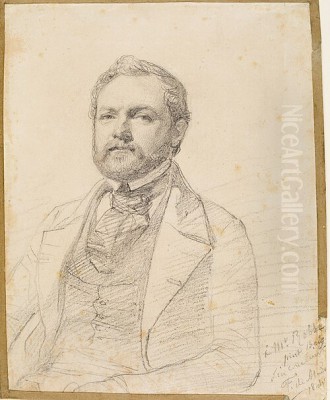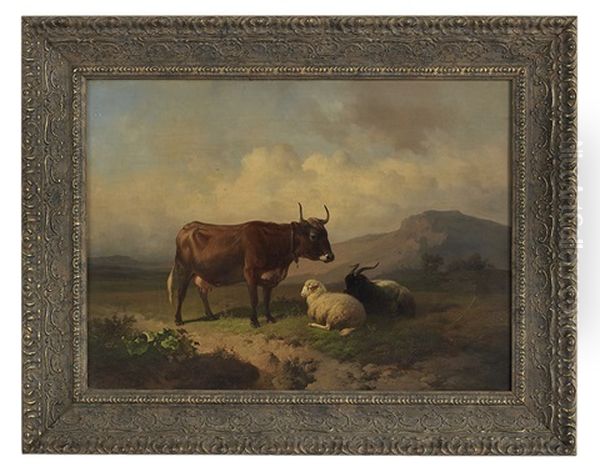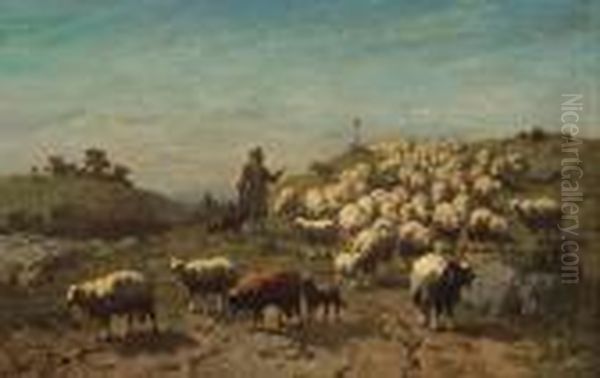
Louis Robbe stands as a significant figure in the landscape of 19th-century Belgian art. Born on November 17, 1806, in Courtrai (now Kortrijk), Belgium, he carved a distinct niche for himself as a preeminent painter of animals, capturing the essence of rural life with remarkable sensitivity and technical skill. Though initially destined for a different path, his passion for art ultimately led him to become one of the leading proponents of Realism within his homeland, leaving behind a legacy that continues to be appreciated for its honesty and artistry. His life spanned a period of significant artistic change in Europe, and his work reflects both the enduring traditions of animal painting and the emerging modern sensibilities of his time. He passed away in Brussels in 1887, concluding a long and influential career.
From Law to Landscape: An Artistic Calling
Interestingly, Louis Robbe's journey into the world of art was not a direct one. He initially pursued and completed training for a legal career. However, the pull towards artistic expression proved too strong to ignore. Robbe eventually made the pivotal decision to abandon his legal profession and dedicate himself entirely to painting. This transition marked the beginning of a focused and fruitful artistic life, centered on observing and depicting the natural world, particularly the animals that populated the Belgian countryside. This change in direction allowed him to channel his energies into developing the skills that would define his career and reputation.
The Heart of His Art: Style and Subject
Louis Robbe's artistic style is firmly rooted in Realism, yet it often carries undertones of the Romantic sensibility that preceded it. He possessed a keen eye for detail, meticulously rendering the textures of animal hides, the play of light on fur, and the anatomical accuracy of his subjects. His primary focus was on domestic animals, with cattle and sheep featuring prominently in his oeuvre. These creatures were rarely depicted in isolation; instead, Robbe situated them within carefully observed landscape settings, often portraying the tranquil pastures and gentle light of the Belgian countryside. His work celebrated the quiet dignity of rural life and the harmonious relationship between animals and their environment.

Unlike purely academic painters, Robbe infused his realistic depictions with a sense of atmosphere and mood. His landscapes are not mere backdrops but integral components of the composition, contributing to the overall feeling of peace and naturalism. He masterfully captured the specific quality of light in the Flemish region, whether it be the soft glow of morning or the warm hues of late afternoon. This sensitivity to light and atmosphere elevates his work beyond simple documentation, imbuing it with a poetic quality that resonated with audiences of his time.
Representative Works and Themes
While specific titles are not always the primary focus when discussing Robbe's extensive output, his representative works consistently revolve around pastoral scenes. Images of cows resting in meadows, sheep grazing under cloudy skies, or herds gathered near watering holes are characteristic of his production. These paintings are celebrated for their technical proficiency, particularly in the rendering of animal forms and the textures of their coats. He excelled at capturing the placid nature of cattle and the characteristic woolliness of sheep.
His compositions often emphasize the calm and routine aspects of agricultural life. They reflect a deep appreciation for the natural world and the animals that inhabit it, viewed through a lens that values authenticity and direct observation. These works stood as testaments to the beauty found in the everyday landscapes of Belgium, contributing significantly to the genre of animal painting within the country. His dedication to these themes made him a specialist highly regarded for his consistent quality and focus.
Influences and Artistic Formation
A pivotal figure in Louis Robbe's artistic development was the renowned Belgian animal painter Eugène Verboeckhoven (1798-1881). Verboeckhoven was already a dominant force in the field, known for his highly detailed and often idealized depictions of animals. Robbe studied under Verboeckhoven, absorbing the technical precision and focus on animal anatomy that characterized his master's work. This tutelage provided Robbe with a strong foundation in the craft of animal painting.
However, while acknowledging Verboeckhoven's influence, Robbe forged his own distinct path. He moved towards a more robust and direct form of Realism, perhaps less idealized than Verboeckhoven's style. Robbe's work often feels more grounded in the tangible reality of the countryside, emphasizing textures and natural light in a way that aligns closely with the broader Realist movement gaining traction across Europe. Some sources also suggest influence or connection with his brother, Philippe-Jacques Robbe, though details remain less documented than his relationship with Verboeckhoven.
The Belgian Art Scene and Contemporaries

Louis Robbe operated within a vibrant Belgian art scene during the 19th century. Belgium, having gained independence in 1830, was forging its own cultural identity, and artists played a crucial role in this process. Realism found fertile ground in Belgium, resonating with a desire to depict the nation's landscapes, people, and industries authentically. Robbe was a key part of this movement, particularly within the specialization of animal painting.
He shared the artistic landscape with numerous other talented individuals. Among his direct contemporaries, particularly those also associated with the circle of Eugène Verboeckhoven or active in similar genres, were figures like Thomas Francia and Eugène Vermeulen. Other artists active in Belgium during Robbe's era included Charles Tilmont and Daniel-Adolphe Robert Jones, who, despite different origins (Jones having British roots), contributed to the artistic milieu in Brussels.
Beyond his immediate circle, the broader Belgian art world included major figures whose work intersected with or paralleled the rise of Realism. Alfred Stevens (1823-1906), though more famous for his elegant depictions of Parisian society women, was a master Realist. His brother, Joseph Stevens (1816-1892), was himself a notable animal painter, focusing often on dogs and scenes of urban life. Constantin Meunier (1831-1905) became renowned for his powerful sculptures and paintings depicting industrial laborers, bringing Realism to social themes.
Landscape painting also flourished, with artists like Hippolyte Boulenger (1837-1871), a key figure in the School of Tervuren, championing plein-air painting and a realistic approach to Belgian nature. Henri de Braekeleer (1840-1888) offered intimate, meticulously rendered genre scenes. Even artists who moved towards Symbolism later in the century, like Félicien Rops (1833-1898), were part of this dynamic period. Furthermore, the influence of French Realism, particularly the work of Gustave Courbet (1819-1877), and the animal paintings of Barbizon School artists like Constant Troyon (1810-1865), were felt within Belgium and likely informed the context in which Robbe worked. Jean-Baptiste Madou (1796-1877) was another older contemporary known for his genre scenes and lithography.
Recognition, Exhibitions, and Acclaim
Louis Robbe achieved considerable success and recognition during his lifetime. His commitment to Realism and his technical mastery earned him respect within the Belgian art establishment and beyond. He regularly exhibited his works at major Salons, not only in Brussels but also internationally. His paintings were shown in prestigious venues in Paris and London, exposing his art to a wider European audience.
His participation in these exhibitions was often met with critical acclaim and prestigious awards. Records indicate that he received gold medals for his work, signifying the high regard in which his paintings were held. This success translated into patronage; his works were sought after by collectors both within Belgium and in other countries, including France and Great Britain. This international appeal underscores the quality and accessibility of his art, which transcended national borders. His reputation was built on a solid foundation of consistent quality and a recognizable, appealing style.
A Crucial Distinction: Not Manuel Robbe
It is important to distinguish Louis Robbe (1806-1887), the Belgian animal painter, from another artist with a similar name: Manuel Robbe (1872-1936). Manuel Robbe was a French printmaker associated with the Belle Époque period. He worked significantly later than Louis Robbe and specialized in different techniques and subjects. Manuel Robbe is particularly known for his mastery of color aquatint and etching, often depicting elegant Parisian women, intimate interior scenes, and atmospheric landscapes.
Confusion can sometimes arise due to the shared surname, but their artistic profiles are distinct. Louis Robbe was a 19th-century Belgian Realist painter focused on animals and rural landscapes. Manuel Robbe was a late 19th/early 20th-century French printmaker known for his sophisticated color prints of modern life. Any discussion of Louis Robbe must maintain this clear distinction to avoid historical inaccuracy, particularly as some sources discussing printmaking techniques or later Parisian art circles might inadvertently conflate the two. Mentions of artists like Louis Legrand or the printer Eugène Delâtre as mentors, for instance, correctly apply to Manuel Robbe's training, not Louis Robbe's.
Scarcity of Personal Details
While Louis Robbe's professional life and artistic output are well-documented through his works, exhibition records, and critical reception, details regarding his personal life remain relatively scarce in readily available historical sources. Information about his family background beyond his initial law training, his marital status, or whether he had children is not commonly highlighted in art historical accounts focusing on his career. Similarly, specific anecdotes or unpublished events related to his private life are not widely known or recorded. The historical focus remains firmly on his identity as an artist and his contributions to Belgian painting. This is not unusual for artists of his era, where biographical details often centered on public achievements rather than private affairs.
Legacy and Enduring Influence
Louis Robbe's primary legacy lies in his significant contribution to the development and popularization of Realist animal painting in Belgium. He successfully blended meticulous observation and technical skill with a sensitivity to the atmosphere and character of the Belgian countryside. His work provided a touchstone for subsequent generations of Belgian artists interested in depicting rural life and the natural world.
He stands as a key representative of the Belgian school of animal painting in the mid-19th century, bridging the gap between the more polished style of artists like Verboeckhoven and the broader currents of European Realism. His paintings remain appreciated today for their artistic merit, their historical value as documents of 19th-century rural life, and their honest, unpretentious portrayal of animals within their natural environment. His decision to follow his artistic passion, abandoning a legal career, resulted in a body of work that secured his place in the annals of Belgian art history.
Conclusion: An Authentic Vision of Rural Belgium
In summary, Louis Robbe was a dedicated and highly skilled Belgian painter whose career significantly shaped the course of animal painting in his country during the 19th century. Transitioning from law to art, he embraced Realism, influenced by masters like Eugène Verboeckhoven but developing his own distinct, grounded style. His focus on cattle, sheep, and the pastoral landscapes of Belgium resulted in a body of work celebrated for its technical finesse, atmospheric sensitivity, and authentic portrayal of rural life. Exhibiting widely and earning international acclaim, Robbe secured a reputation as a leading artist of his time. Though distinct from the later French printmaker Manuel Robbe, and with personal life details remaining elusive, Louis Robbe's artistic legacy endures through his masterful and evocative paintings of the Belgian countryside.